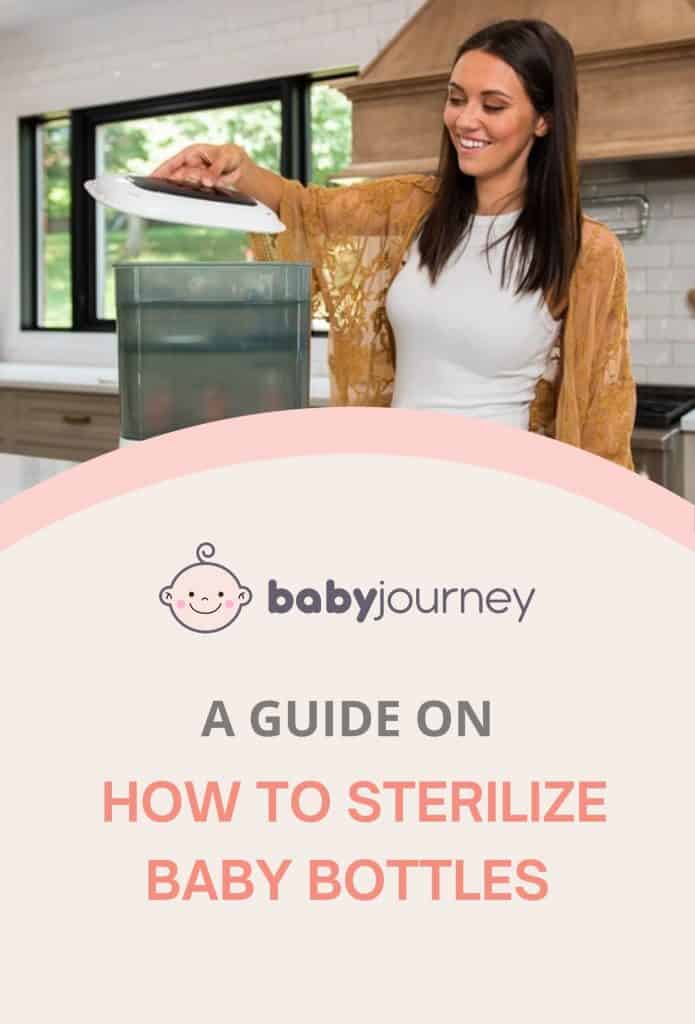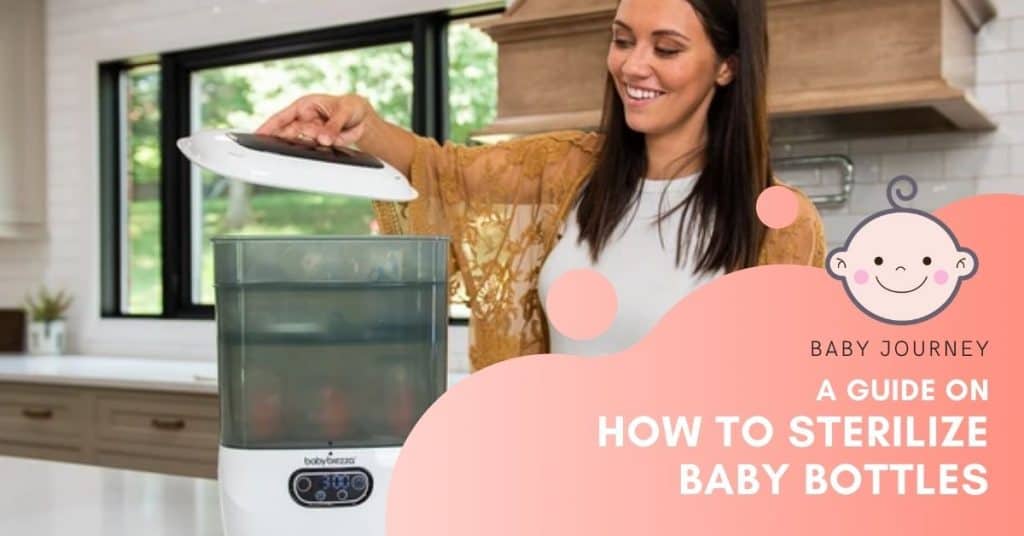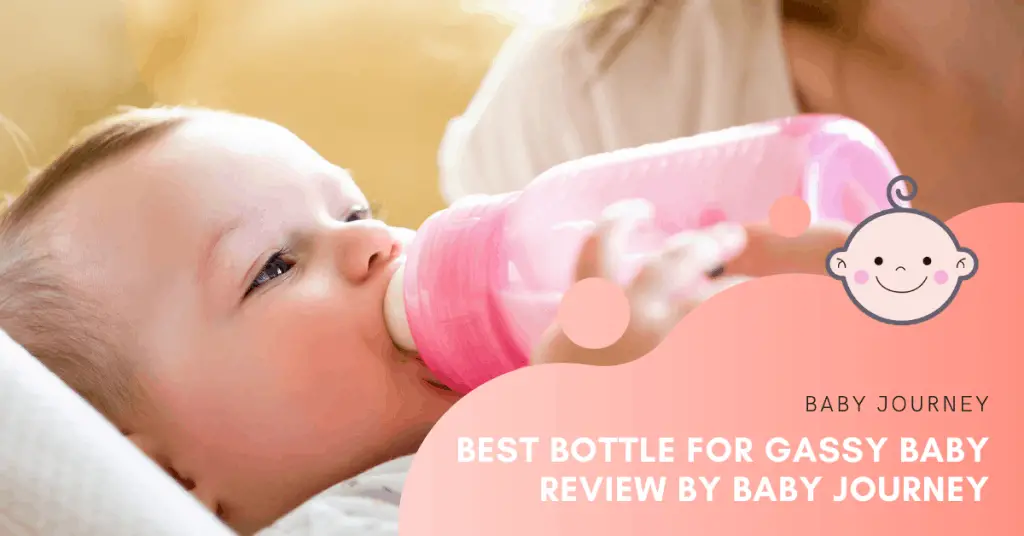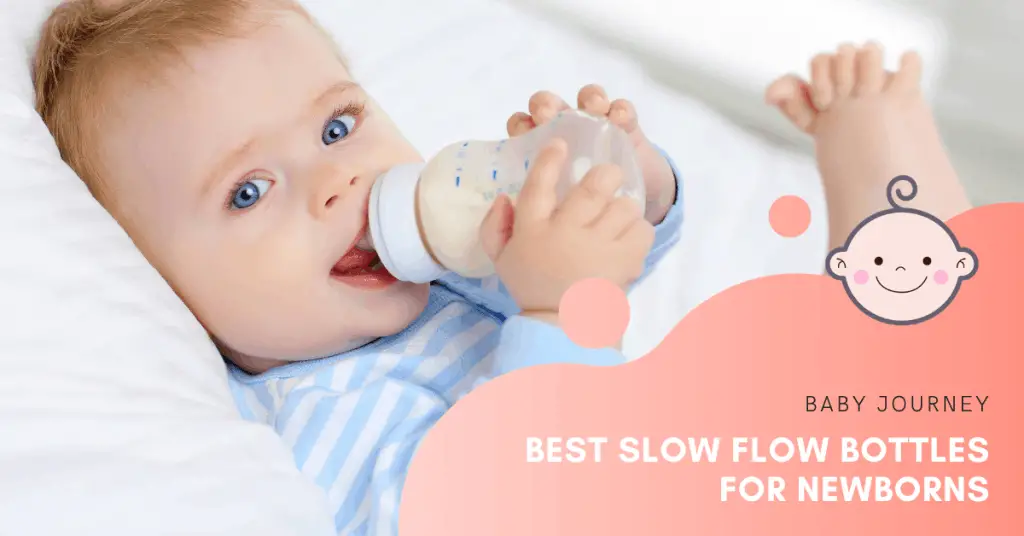As a parent, my top priority is keeping the child safe, healthy, and happy. One way to ensure that is to take proper care of equipment and stick to your cleaning schedule, especially when it comes to sterilizing baby bottles.
I will explain how to sterilize baby bottles in different ways. Therefore, choose what works best for you to keep the baby bottle clean.
But, before I hop on to the best method that I tested myself, let’s learn more about the importance of properly cleaning and frequently sanitizing baby equipment, not just bottles but nipples, pacifiers, and other items.
How To Clean Baby Bottles Properly?
Once you finish feeding the baby, clean the bottle and other equipment with hot and soapy water. Cleaning brushes are useful to ensure there are no food residues that may attract unwanted pests in your home. Also, the brushes need to be clean and used only for bottles.
You can turn the nipple inside out to clean it thoroughly with soapy water. Rinse with hot water once you are done. The next step is sterilization.
Why Do Baby Bottles Need To Be Sterilized?
How to wash baby bottles properly includes removing the visible dirt and food leftovers, but it is quite different from sterilizing. Sterilizing baby bottles significantly reduces the risk of diarrhea, vomiting, and other infections.
Sterilization is the only way to eliminate nasty spores as transmissible agents because cleaning removes only the dirt and milk leftovers. Disinfection is helpful because it kills microorganisms, but sterilization is the most comprehensive way to keep the baby bottle safe for use.
Besides, newborns and babies younger than one year are building their immune systems, so removing everything that can potentially harm them is necessary.
If you don’t sterilize baby bottles, it can lead to bacteria spreading and cause acute diarrhea, which sometimes can require hospitalization. Food poisoning, rotavirus, or Hepatitis A are the potentially severe consequences of not sterilizing baby bottles. Moreover, milk is especially prone to developing microorganisms.
Therefore, it’s a reason more to put extra effort when taking care of baby bottles.
What Else Do You Need To Sterilize?
The answer is simple – everything that will be in your baby’s mouth requires sterilization. That includes nipples, pacifiers, bottle rings, breastfeeding pump parts, etc.
Pacifiers need special attention because the baby can drop them on the floor often (one of the many reasons why you need to get more than one pacifier). Therefore, pacifiers come in contact with different pathogens, and you cannot remove them only by washing them.
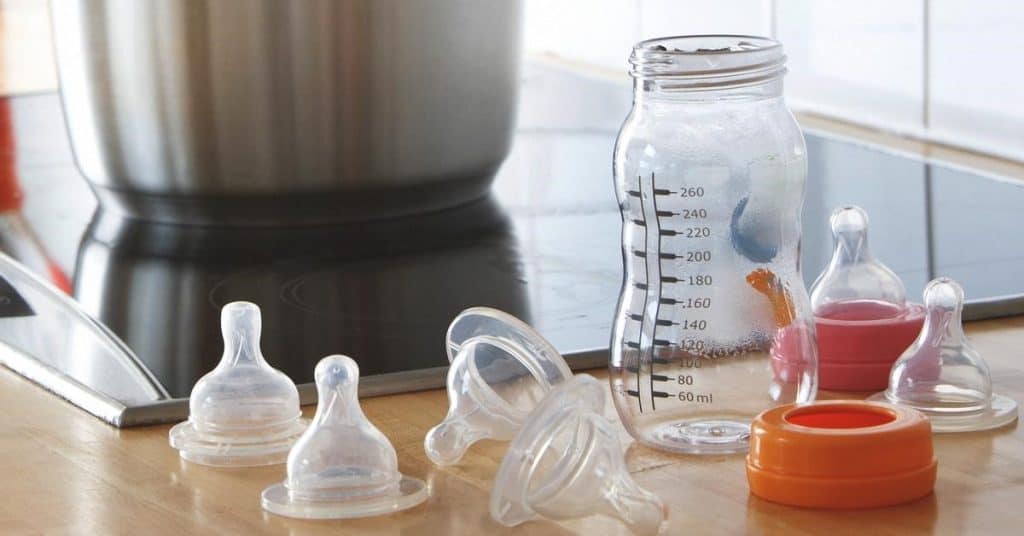
Sterilization Methods
Let’s briefly go through different techniques on how to sterilize bottles. Moreover, we will see if sterilizing plastic bottles is different from taking care of glass bottles.
The sterilization methods are different – some are more convenient and cost-effective than others. However, if done properly, every method is sufficient for keeping the bottles sanitized.
The most common methods for sterilization baby bottles are the following:
- Microwaving
- Boiling
- Soaking in diluted bleach
- Using bottle sterilizer
- Using cold water and sterilization liquids or chemicals
- UV Sterilization
- Using the dishwasher
Is Sterilizing Plastic Bottles The Same As Sterilizing Glass Bottles?
The bottle material is important when you are deciding the appropriate methods. If you have been wondering how to sterilize glass bottles, good news – it is simpler than plastic bottles!
Glass is tougher than plastic, and it can withstand heavy heat and the use of different chemicals.
But, boiling baby bottles works for both plastic and glass bottles. Still, before you put the bottles in the pot with boiling water, I recommend checking the manufacturer’s guidelines on proper care.
Which Method Is The Best?
Still, when comparing all sterilization methods, it is worth considering your lifestyle and preferences. The Center for Disease Control and Prevention (CDC) lists several methods as equally effective.
Those are dishwashers, boiling, and using bleach to remove bacteria. CDC also recommends frequent cleaning of brushes and basins that you use for cleaning the bottles.
Moreover, the Center recommends avoiding blenders for mixing baby formula as they are hard to clean. You can read more on how to sanitize baby bottles, recommended by CDC here.
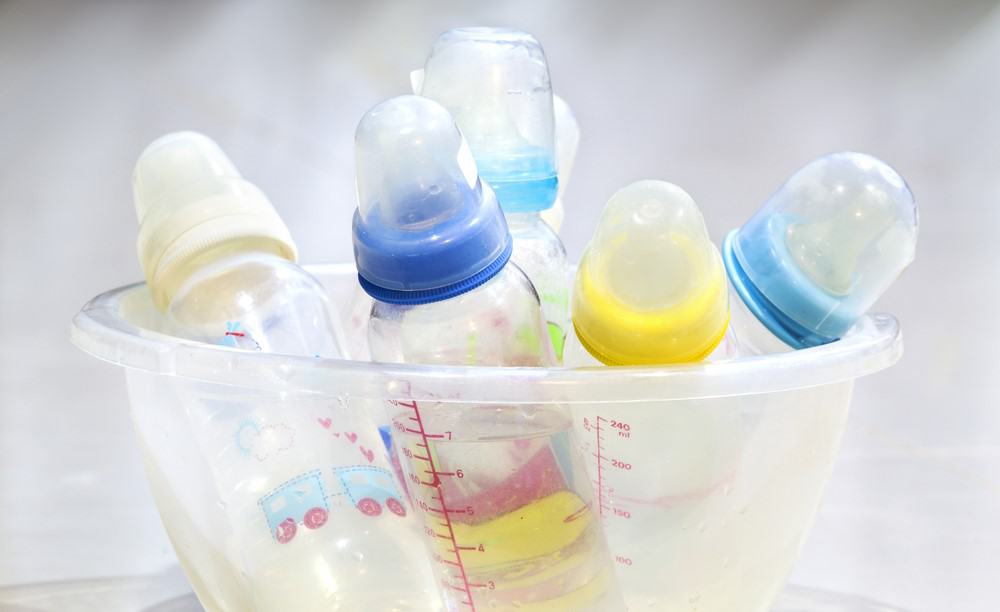
7 Proven Methods on How To Sterilize Baby Bottles
Now, let’s go step by step through each sterilizing method. I will also highlight the benefits of choosing one method over the other, and you find what works best for you.
#1 How To Sterilize Baby Bottles In Microwave
Sterilizing baby bottles in the microwave is one of the simplest methods. All you need to do is fill the baby bottle with water up to half, put it in the clean microwave, and set it on high.
Microwave the bottle for two minutes and remove the bottle from the microwave. Then, dump the water and let the bottle air dry.
However, I recommend this method only with glass bottles, and you need to wash them first to remove the formula leftovers.
Additionally, you can get a microwave bottle sterilizer – an appliance designed specifically for baby bottles. These are usually less pricey than electric sterilizers and can hold several bottles at a time.
I prefer the Philips Avent microwave sterilizer, as it is affordable, effective, portable, and can hold up to four bottles at a time. The working principle is the same as with a standard microwave.
#2 How To Sterilize Baby Bottles By Boiling Them
Boiling baby bottles is safe for both glass and plastic bottles and requires only a deep pot and water. If you want to know how to sterilize bottles and pacifiers at the same time, boiling is the answer.
Put pacifiers and baby bottles in a pot and fill it with water enough to cover it. Put the lid on and bring water to boiling. Then, let it boil for five minutes and remove the bottles and pacifiers from the water.
Place them on a clean and dry cloth and let air dry.
#3 How To Sterilize Baby Bottles With Bleach
Sterilizing baby bottles with bleach is intimidating for many parents. But, if you follow the steps and methods described by CDC, the process is completely safe and effective against germs, bacteria, and all harmful microorganisms and spores.
Things you will need are unscented bleach, clean water, a basin, and a tablespoon. Mix two teaspoons of bleach per gallon of water (16 cups). Make sure that the basin is clean and submerge bottles and pacifiers completely.
Additionally, squeeze the water through the nipple to ensure that every inch of the bottle is sanitized. Let it sit for at least two minutes and put the bottles and pacifiers on a clean, dry cloth to air dry.
Don’t worry about bleach staying on the baby bottles. As it dries, the remaining bleach will break down and the bottles will be completely safe for use.
Moreover, many restaurants usually apply this method when sterilizing their dishes.
#4 How To Sterilize Bottles With An Electric Steam Sterilizer
Electric steam sterilizers are simple to use, effective against germs and bacteria, and won’t damage the bottles. On the other hand, they can be bulky and pricey.
The sterilization process is completely automatic. All you have to do is fill the bottles with water according to the manufacturer’s instructions, put clean bottles in the sterilizer, and turn the switch. The device will turn off once the sterilization is complete!
Some of the best electric bottle sterilizers in the market include Papablic Baby Bottle Electric Steam Sterilizer and Dryer and Baby Brezza sterilizer.
Do I need a bottle sterilizer? As you can see, using an electric sterilizer is similar to microwave sterilization. I recommend it if your budget allows you to buy a device such as this, and you have space on the kitchen counter for it.
On the other hand, other methods are just as safe and effective in sterilizing baby bottles.

#5 How To Sterilize Baby Bottles With Cold Water
Can you sterilize baby bottles with cold water? The answer is yes, but you need the help of the sterilization tablets.
There are different products for cold-sterilization on the market – powders, liquids, and tablets. Depending on the product, you will have to dissolve the tablet or powder in a certain amount of water (follow the manufacturer’s instructions for the proportion). Then soak the baby bottles in the mixture for the time specified in the instructions.
For most products, usually, half an hour is enough for complete sterilization. Also, you can use the same mixture for 24 hours, without having to make it again. It is because chemicals in the solution or tablet are effective against germs for a certain time.
When using this method it is important to wash the basin where you dissolve the tablet before and after every use. Moreover, I recommend this method for traveling as you can do it everywhere where you have access to water as long as you bring your tablets with you.
#6 How To Sterilize Baby Bottles With A UV Sterilizer
UV sterilizers are useful and convenient household appliances that you can use to keep other things sterilized and not only baby bottles.
It uses UV rays to kill harmful germs, bacteria, spores, and other microorganisms. You can use it for plenty of things and baby gear, including breast pump parts, nipples, pacifiers, spoons, etc.
The working process is simple. Wash the bottle, and put it in the UV sterilizer, press the button, and the device will do its magic. Not only will it sterilize bottles, but it will dry them, too. The Wabi UV-C Sterilizer and Dryer is a great option if you intend to UV sterilize and dry your baby items in one go.
These sterilizers are great things to have in your home, as you will probably continue to use them long after your child stops using bottles. Still, they can be bulky and pricey.
#7 How To Sterilize Baby Bottles In The Dishwasher
Washing baby bottle in dishwasher with other dishes keeps it clean but not sanitized. Only when you run the hot water cycle and a heating drying cycle can you be sure that all germs are gone.
Additionally, you should check your dishwasher manual to see if the device has NSF/ANSI Standard 184 Certification. Only dishwashers with the certification have the appropriate sanitize cycle and can produce enough heat to sterilize dishes. If your dishwasher has it, you can use it to sterilize the bottles and other baby equipment.
Can I wash baby bottles in the dishwasher? The answer to this question depends on the bottle. Most of the modern bottles are dishwasher-safe, but you should still check the bottle label.
Next, put the bottle on the top rack and other accessories such as nipples and pacifiers in the dishwasher basket. Set the sanitize cycle, and you can expect the bottles to be sterilized and ready for use when the cycle is complete.
How Often Should You Sterilize Baby Bottles?
The first thing to do when you buy baby bottles, pacifiers, nipples, rings, and other accessories, is to sterilize them before first use. After that, you should sterilize bottles at least once a day, according to the Centers for Disease Control and Prevention.
However, you don’t have to sterilize the bottles before every use, but you should do it more frequently in the following situations:
- When the baby is younger than three months
- When the baby is born prematurely
- When the baby is sick, to prevent re-infection
- When you haven’t use the bottle for a while
- Before first use
- If the baby has health issues
As the baby grows, you can slowly reduce the sterilization frequency to several days, until you decide to stop doing it.
How Long To Sterilize Bottles?
You should sterilize baby bottles at least until the baby is one year old, and it builds a stronger immune system. Additionally, you can continue sterilizing baby feeding equipment for longer occasionally, but you don’t have to do it so often.
Bottle Sterilization Precautions
When sterilizing baby bottles, there are several things to have in mind to ensure you are doing a good job and doing no harm to the baby.
- Keep your hands, dry cloth, and kitchen counter clean and disinfected
When completing the sterilization process, make sure to wash your hands with soap and water before you touch the sterilized bottle or other pieces of baby equipment.
Next, make sure that the drying cloth you use to put the bottle and pacifiers to air dry is unused and clean.
Don’t forget to clean and disinfect the kitchen counter or any other surface where you store the sterilized bottles.
- Read the labels
First of all, when buying the baby feeding equipment, make sure it is BPA-free. Next, check the label to see which methods are safe to use on the bottle and if the nipples are different.
- Kill the bubbles
When soaking the bottles in boiling water or cold water with a dissolved sterilization tablet, make sure there are no air bubbles in the bottle. If there are air bubbles, they can cause superheating and potentially burn you.
Also, when doing the boiling sterilization method, keep the pan or pot shut.
How Do You Dry Bottles After Sterilizing?
The best and safest method to dry your sterilizing bottles is to let them air dry on a clean and disinfected surface. Moreover, never wipe the bottles with a dry cloth or towel because you can contaminate them.
Once the bottle is dry, you should wash your hands and put the nipple back on when you’re about to feed the baby.
FAQs About Bottle Sterilization
Let’s answer more questions about taking proper care of bottles. If you have more of these, pop them out in the comment section, and I’ll be happy to clear up any misunderstandings.
- Does a bottle sterilizer replace washing?
No, sterilization is an additional step in removing germs. Use soap and water to clean the bottle and brush to scrub the milk and food leftovers. Sterilization is done on clean bottles that you have already washed.
- How long does a bottle stay sterilized?
When stored inside, in a clean, dry, and disinfected place, the bottle can stay sterilized for 24 hours.
- What is the safest way to sterilize baby bottles?
All methods I described above are safe when done properly. But, boiling the bottles is the most natural method. It doesn’t require the use of chemicals or specific devices that can malfunction.
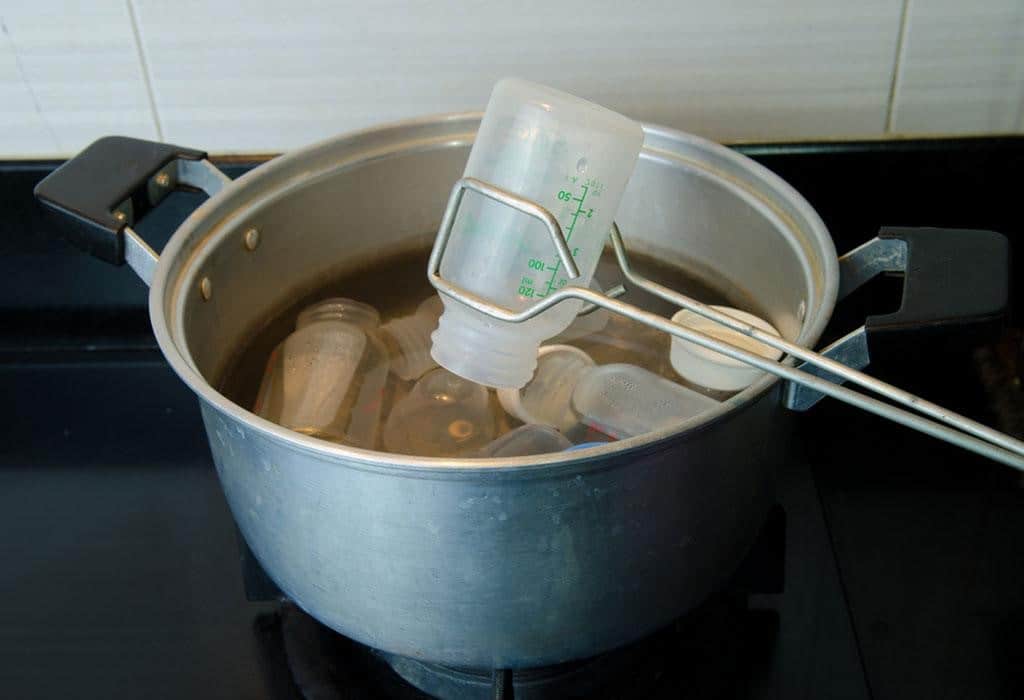
- At what age do you stop sterilizing baby bottles?
It is safe to stop after the baby turns one, but you can relax the sterilization practice a couple of months before.
- Is it safe to clean baby bottles with bleach?
Using only bleach to clean the bottles is harmful, but you can safely dissolve two tablespoons of bleach in one gallon of water and use the solution to sanitize bottles.
- Where do you store sterilized baby bottles?
The safest place to store sterilized bottles is the sealed container in your refrigerator. It will reduce the risk of germs and bacteria developing.
Conclusion
Sterilizing baby bottles and other feeding equipment is necessary to remove all the germs, bacteria, spores, and other harmful pathogens. Standard cleaning with soapy water only removes dirt but won’t kill all germs.
Conveniently, you can sterilize bottles differently, either by boiling the water, using chemicals, or doing it in a specialized device.
If you prefer a hassle-free microwave method like me, I recommend the Philips microwave bottle sterilizer – it offers great value for the money and is one of the easiest and time-saving options for bottle sterilization.
Which sterilization method seems simple to you – dishwasher or boiling? Which one would you choose for traveling – cold-water sterilization or portable sterilizer? Share your thoughts below!
